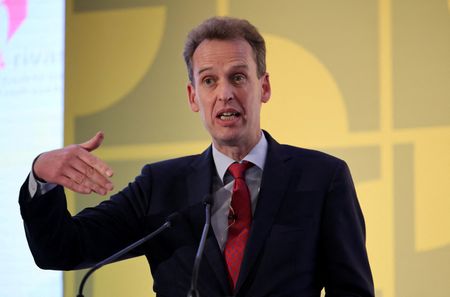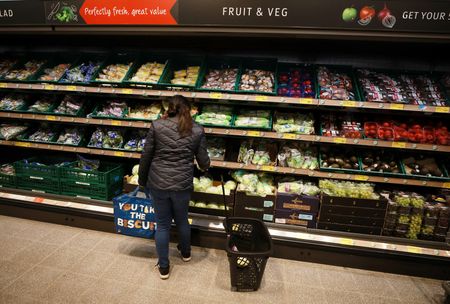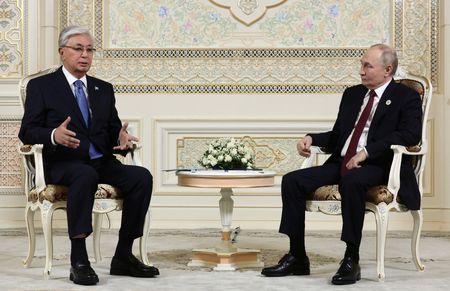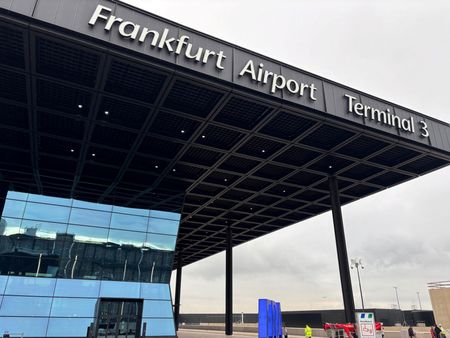By David Milliken and Andy Bruce
LONDON (Reuters) -The Bank of England cut interest rates by a quarter-point and some policymakers wanted a bigger move to offset a slowdown, but the BoE said it would be careful about further moves in the face of an expected inflation spike and global economic uncertainty.
The BoE halved its 2025 growth outlook – a blow for finance minister Rachel Reeves who is pushing to speed up the economy – and said inflation would be almost double its 2% target this year. Governor Andrew Bailey said he thought that would prove to be a “bump in the road” before inflation falls back.
Thursday’s rate cut to 4.5% from 4.75% was in line with expectations in a Reuters poll of economists.
But investors were surprised that Catherine Mann – previously the Monetary Policy Committee member most opposed to rate cuts – joined Swati Dhingra to seek a bigger reduction to 4.25%.
Bailey said he expected to be able to cut rates further. “But we will have to judge meeting by meeting, how far and how fast,” he said.
Financial markets initially interpreted the announcement as heralding faster rate cuts this year. Sterling fell as much as 1% on the day versus the dollar but then recovered.
“Outside of the surprise voting outturn… other parts of the BoE communications look more hawkish suggesting that some caution should be taken in over-interpreting what the dovish vote split means for the rate outlook,” Nikesh Sawjani, senior UK economist at Lloyds Bank, said.
Investors priced in two or three more quarter-point rate cuts by the end of 2025, little changed from earlier.
Hit by worries among businesses about the economic policies of the new Labour government, the risk of a global trade war led by U.S. President Donald Trump and rising costs, Britain’s economy has barely grown since mid-2024.
The BoE said economic output likely contracted by 0.1% in the three months to December and halved its growth forecast for 2025 to just 0.75%, reflecting weak business and consumer sentiment and more sluggish productivity growth.
The central bank said it was unclear exactly how any future U.S. trade tariffs would affect inflation in Britain, but higher global tariffs were likely to cause slower growth.
Bailey said global uncertainty was a factor behind the decision to add the word “careful” to the bank’s guidance about its future stance on rate cuts, which it continued to also describe as “gradual”.
Thursday’s cut is only the third since the BoE started lowering borrowing costs from a 14-year high in August. It leaves British rates among the highest for advanced economies.
Some BoE policymakers wanted a “cautious” approach to future cuts because of weak productivity that could push up inflation.
Others saw less risk of persistent above-target inflation and preferred what they called a “careful” strategy, which could indicate a greater willingness to reduce rates.
DARKER OUTLOOK
The outlook for Britain’s economy is worse than when the BoE published its last full set of forecasts in November.
Inflation – already above target at 2.5% – is expected to peak at around 3.7% in the third quarter of this year due to higher energy prices and expected increases in regulated water bills and bus fares, up from a previous forecast peak of 2.8%.
The BoE forecasts do not show inflation returning to its 2% target until the end of 2027, six months later than before.
Bailey repeatedly said inflation would weaken due in part to a labour market slowdown, including slower wage growth and slightly higher unemployment.
Forecasts for economic growth in 2026 and 2027 were nudged up to 1.5% from 1.25%.
The forecasts were based on market expectations for a slower pace of rate cuts than in November, with interest rates dropping to around 4.25% this year versus about 3.75% expected before.
If taken at face value, the forecasts imply the BoE only has room to cut interest rates by a further quarter-point this year if it wants inflation to slowly return to target. But Bailey said the forecasts were only one factor in the MPC’s decision.
The two policymakers who voted to cut rates to 4.25% each had a different reason with one them described as supporting an “activist” approach, the language previously used by Mann.
That policymaker said her vote for a half-point cut was intended to give “a clearer signal of financial conditions appropriate for the United Kingdom” although interest rates were still likely to need to stay high.
The other policymaker said the a bigger rate cut was more consistent with how weak demand was likely to lower inflation.
(Writing by David Milliken and William Schomberg; Graphic by Sumanta Sen; Editing by Catherine Evans, Hugh Lawson and Toby Chopra)










